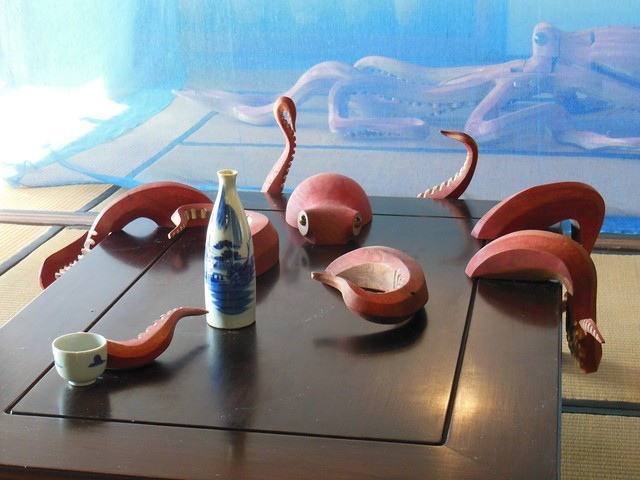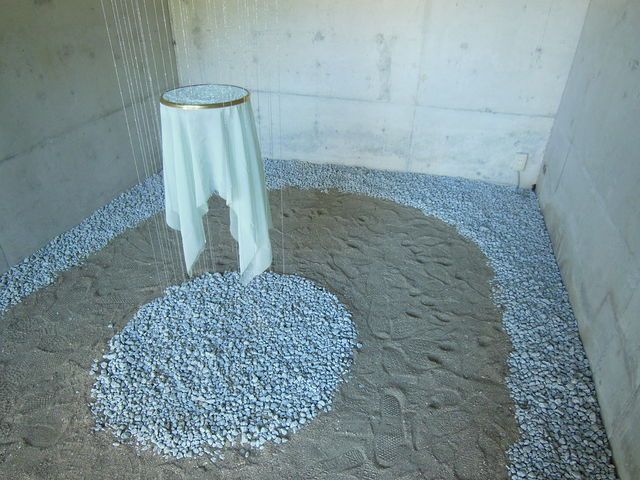Setouchi Triennale 2013 Autumn Session
| Travel Reports by Rabbityama | view profile of Rabbityama |
| previous post |
| next post |
| Note: The opinions and views expressed in this user report are those of the individual author and do not necessarily reflect the opinions and views of japan-guide.com. |
October 20, 2013 - Setouchi Triennale 2013 Autumn Session

Although the Setouchi Triennale has been going on through the spring and summer sessions, the autumn session brings with it three new islands: Honjima, Takamijima, and Awashima.
As I finished my summer session trip over a month ago, the thought had lingered in my mind to possibly come again to visit these islands, and as is often the case, once such ideas are planted it was only a matter of time before I made the plans and made the trip!

TAKAMIJIMA
In terms of the art, I was most excited about visiting Takamijima after looking at the festival's website. The art here is all made by artists associated with Kyoto Seika University.
The Transition House (#121) is a dark, empty home with holes in the walls and ceiling that let light shine through. It was pretty and reminded me of Sarah Mclachlan's 'Building a Mystery' music video (or Korn's 'Freak on a Leash' video).
The House of Pyrethrum (#123) contains cones of mosquito coils that they will burn throughout the festival period. Pyrethrum, which is used to make the coils, was once produced here on the island, so the work pays homage to the island's history.
I was most looking forward to seeing #122 House of Octopus, because it looked interesting and was a fun theme. The work features an octopus serving sake from within a table and another octopus behind a screen on the first floor and many pots with tentacles coming out on the second floor. The work definitely met my expectations as being both fun and interesting.



AWASHIMA
After visiting Takamijima, I took a boat directly to Awashima. Awashima was once home to the National Mercantile Marine School, Japan's oldest naval training school and has been declining in population since the school closed, but the old school is open now as a museum. During the art festival, it also houses some of the artwork including the Koppe Sandwich Shop which sells sandwiches made by a favorite local bakery using local ingrediants.
Some of the works I enjoyed include #126 Subtle Intimacy. This work contained glass windows fired with pressed plants inside. The plants were picked by the artist together with the islanders. The process of finding and collecting the plants together is the 'subtle intimacy' the artist says the name references. It's very pretty. #127 Embarkation features tiny white boats placed together to make one large boat. The back of the boat becomes rather loose which is meant to resemble a school of fish swimming.
The most interesting and popular work on Awashima has to be #128 Missing Post Office. 'Missing Post Office' is written outside on the post office and the postal sign. Inside, you can read postcards. What is really interesting though is that they actually have actors to be the postal workers in the defunct post office. They're very friendly and many people get their pictures taken with them. They also sell postcards.



HONJIMA
Although there are guides to Takamijima and Awashima has the naval training school to attract visitors, Honjima is the most established tourist destination, with the most non-art sites for tourists. The Kasashima area has been designated as one of Japan's preservation districts for its scenic streets aligned with old Edo Period houses. It's worth visiting even without the art, but the festival certainly adds another element of enjoyment.
I found many of the works here to be quite interesting. #112 To Be Here was made to incorporate nature back into concrete structures and make visitors feel a sense of 'family' (with both flora and fauna, according to the guides here). Clovers were purposefully planted over the entire area around the art. The designs on the glass ceiling of the house were actually made using clover seeds.
Taste the Buddhism (#165) is edible art consisting of tea and ice cream covered in white chocolate in the shape of a lotus placed atop a leaf. Lotuses are important symbols in Buddhism.
The New Port-Masala Blue is an unnumbered work. Members of the Santal ethnic group in India were brought here to make a house in their own traditional style. It's an interesting project with one aim to promote and create awareness about India's minority groups.
One of my favorite works on Honjima is #110 Bridge. Honjima once had many temples but over time, patronage has decreased and the island now has very few active temples. The artist wanted to revive one of the abandoned temples. Outside the temple are interesting depictions of what I assume were photographs. The temple itself features large red balls in the vegetation surrounding a bridge in the temple grounds. A large ball also replaces the temple's bell. Across the bridge, the hall is covered in silver foil. The artist has definitely brought people back to the temple!
My Setouchi Triennale experience is now over (again). The festival is a lot of fun with a broad range of works with some being interactive, others thought-provoking, and many just being fun and interesting to look at! Those considering going to the festival should definitely try and make it! It's well worth it! Some of the art will remain on the islands, so visitors can see them even after the festival has ended.




| previous post |
| next post |
|
List of Posts:
2017/08/17 - Obon Festivals and Events 2016/10/13 - Biwako Biennale 2013/10/20 - Setouchi Triennale 2013 Autumn Session 2013/09/18 - Setouchi Triennale 2013 Summer Session (Part 2) 2013/09/18 - Setouchi Triennale 2013 Summer Session (Part 1) 2013/01/03 - New Years in Okayama |
